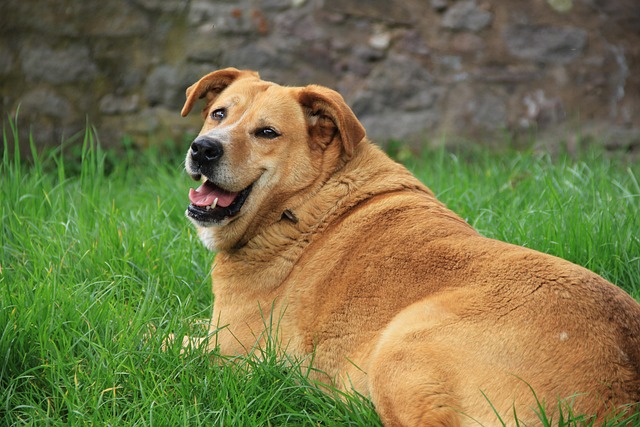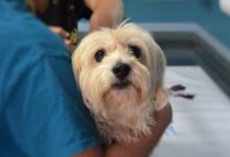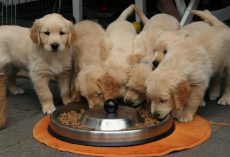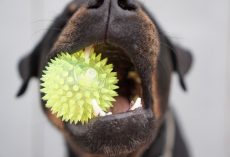Belly rubs are extra cute when your pup is a little round — but too much extra weight can lead to serious health issues. The good news? It’s usually easy to spot the early signs of weight gain, and there are plenty of ways to help your dog get back to a healthier size.
Here’s how to tell if your dog is overweight and what you can do to support him.
How To Tell If Your Dog Is Overweight
Sometimes weight gain happens slowly — one day your pup looks the same as always, and the next you’re noticing a fuller belly or a rounder shape.
Signs your dog may be overweight include:
- Difficulty getting up or jumping
- Getting tired or winded quickly
- Slower walks or hesitation on stairs
- Extra panting during mild activity
But the most accurate way to check is by using a body condition score (BCS).
What Is a Body Condition Score?
A body condition score is a visual and hands-on assessment that vets use to determine if a dog is underweight, overweight or just right. It works similarly to a human BMI — not perfect, but a reliable guideline.
Here’s how to check your dog’s BCS at home:
1. Feel the ribs
You should be able to feel your dog’s ribs with gentle pressure.
- Too thin: Ribs are very prominent
- Healthy: Ribs easily felt, slight fat covering
- Overweight: Ribs difficult or impossible to feel
2. Look from above
Your dog should have a visible waist behind the ribs. If the waist disappears or the body looks round, that’s a sign of extra weight.
3. Look from the side
Your pup’s belly should tuck upward. A sagging belly or round abdomen usually means he’s overweight.
As dogs pack on extra pounds, their ribs become harder to feel, their waistline fades and their belly shifts lower.

Why Is My Dog Gaining Weight?
Most dogs gain weight because they’re eating more calories than they burn — simple as that. Too much food and too little exercise is the most common combination.
But other factors can cause weight gain, too, including:
- Hypothyroidism
- Cushing’s disease
- Diabetes
- Pregnancy
- Side effects from medications
- Joint pain or arthritis
- Stress or depression
Age, breed and spay/neuter status also play major roles. Many breeds — such as Labradors, beagles, pugs, dachshunds and golden retrievers — are more prone to weight gain.
If your dog is gaining weight despite normal feeding and exercise, talk to your vet to rule out underlying conditions.
Health Risks for Overweight Dogs
Carrying extra weight may seem harmless, but it can lead to a long list of medical problems, including:
- Arthritis and joint pain
- Diabetes
- Heart and lung issues
- High blood pressure
- Kidney and liver problems
- Certain cancers
If your dog is overweight, creating a weight-loss plan with your vet can help prevent long-term damage and improve his quality of life.
How To Help Your Dog Lose Weight
First, determine why your dog is gaining weight. If a medical issue is involved, it must be treated before weight loss can be successful.
If it’s simply a matter of too much food and not enough activity, then the solution is a balanced approach:
controlled calories + more exercise = safe, steady weight loss
Healthy weight loss takes time — usually several months — so slow progress is still success.
Here’s how to help your dog slim down safely:
1. Switch to a Weight-Loss Dog Food
There are several types of diet dog foods:
- Lower-calorie formulas
- High-fiber, high-protein blends
- Prescription diets designed for weight loss
Try this Purina Pro Plan Overweight Management wet food from Amazon
These foods help your dog feel full without consuming too many calories. Always check with your vet before changing your dog’s diet to make sure it’s the right choice.
And don’t forget: measure meals to prevent accidental overfeeding.
2. Cut Back on Treats
Treats are tiny but calorie-heavy — and they add up fast.
Vets recommend keeping treats to about 10% of daily calories.
A good rule of thumb:
A small piece of cheese for a 20-pound dog is like a person eating several cheeseburgers.
Try these Purina Pro Plan Veterinary Diets Gentle Snackers Low Fat Dog Treats from Amazon
Instead of food rewards, try:
- Extra playtime
- Belly rubs
- A long walk
- A favorite toy
3. Increase Daily Exercise
Exercise is essential for weight loss and maintaining lean muscle. Even a short additional walk each day makes a difference.
Try adding:
- A second or longer daily walk
- Fetch or tug sessions
- Puzzle toys that encourage movement
- Trips to the dog park
Not only will it help your dog slim down — it’ll also strengthen your bond.
The Bottom Line
Weight gain happens, and it’s nothing to be ashamed of — but it’s important to address it early. With the right plan, your dog can return to a healthy weight, feel more energetic and enjoy a happier, longer life (like this obese rescue dog who can’t stop smiling because she lost half her weight).
Talk to your vet, adjust your dog’s food and exercise, and celebrate every bit of progress along the way. Your pup will thank you with a healthier, happier tail wag.
We independently pick all the products we recommend because we love them and think you will too. If you buy a product from a link on our site, we may earn a commission.











